
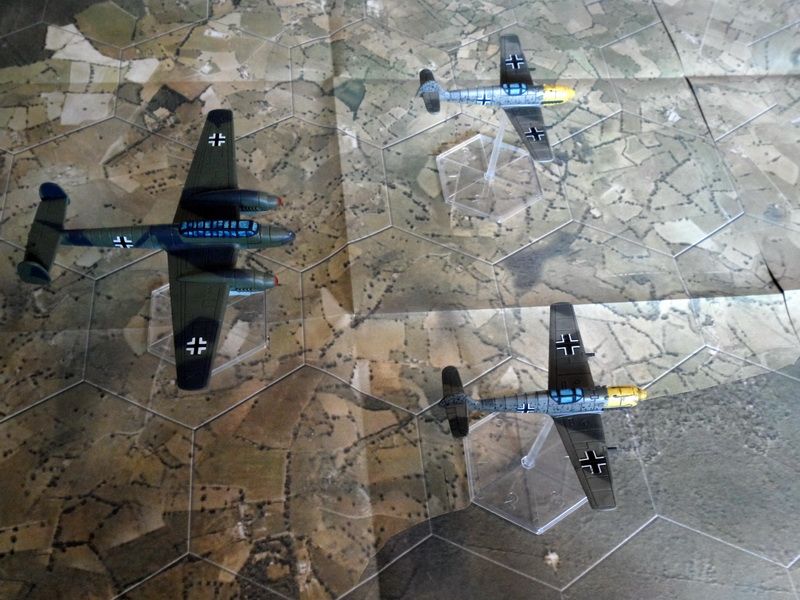
 Following up on the unboxing post with a review of the game and a rules overview combined. I can start out by saying that Axis & Allies: Angels 20 is a pretty easy game to learn, there aren't many rules, and the way it plays makes it perfect for either quick games at home or as participation games down at the club or a convention. It's a game with very limited amount of components so you can begin to play within minutes of tipping out the box contents on the table and is one of two good reasons of bringing it to a convention over Star Wars X-wing (which is an excellent game).
Following up on the unboxing post with a review of the game and a rules overview combined. I can start out by saying that Axis & Allies: Angels 20 is a pretty easy game to learn, there aren't many rules, and the way it plays makes it perfect for either quick games at home or as participation games down at the club or a convention. It's a game with very limited amount of components so you can begin to play within minutes of tipping out the box contents on the table and is one of two good reasons of bringing it to a convention over Star Wars X-wing (which is an excellent game). One is that X-wing has you sort through a lot of tokens, markers, range sticks etc. before you can play, and takes some time to clean up afterwards in an organized fashion. The other reason is, as mentioned in my unboxing post, that the planes themselves are sturdy pieces of hard plastic with no small or loose part. You can't break them, and the flight stands are not as fragile as the ones you find in SW: X-wing.
With that comparison out of the way, let's talk about the rules.
The game is hex based for movement, and has you roll D6 dice to generate shooting results, turn initiative and perform maneuvers. Players take turns in activating 1 plane at a time, with the player who won initiative moving and firing second. If outnumbered the player who won initiative has his opponent move airplanes until the initially outnumbered player has more planes left to activate.
The dead simple core mechanics utilize pilot/aircraft cards which come with a bunch of stats that describe the abilities and performance values of your plane. To understand the game we might as well start with explaining how these work, using the cards below as an example.
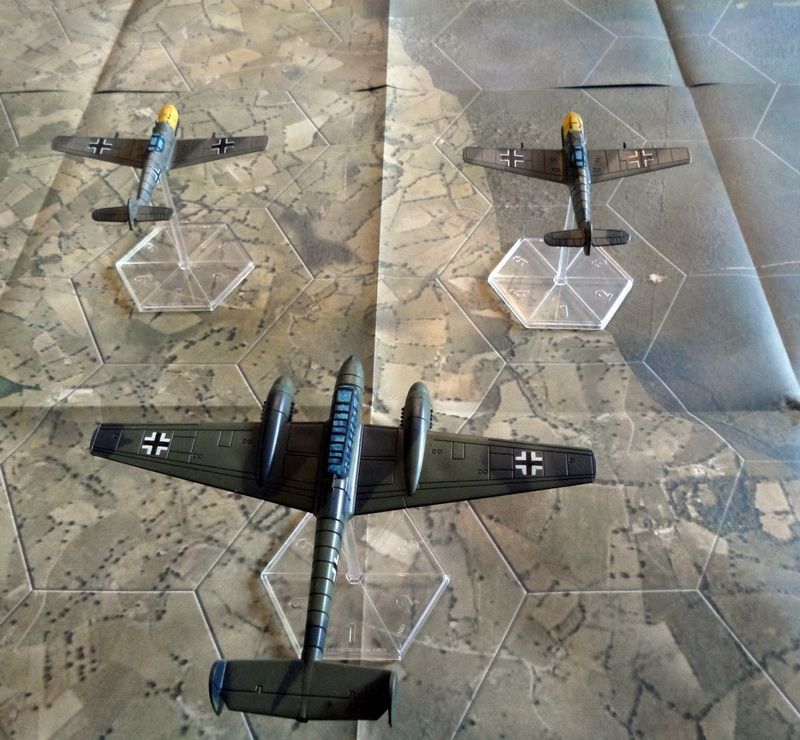
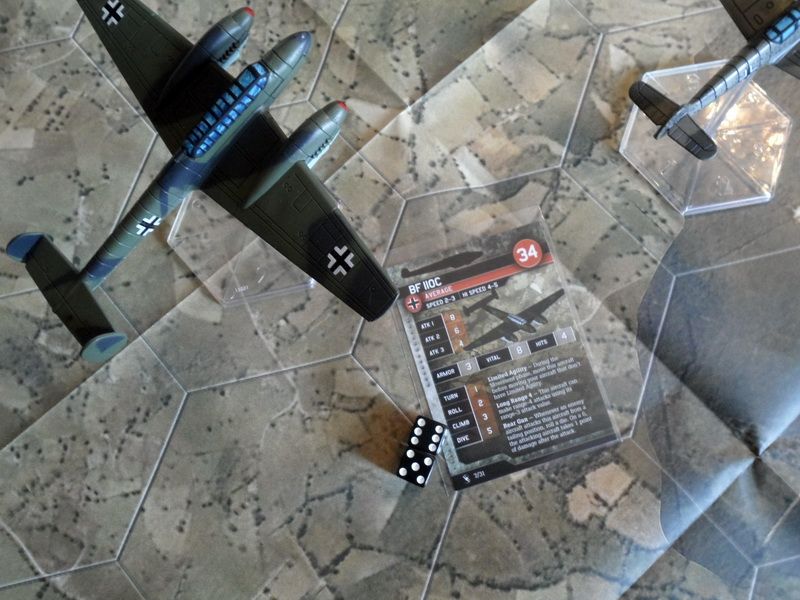
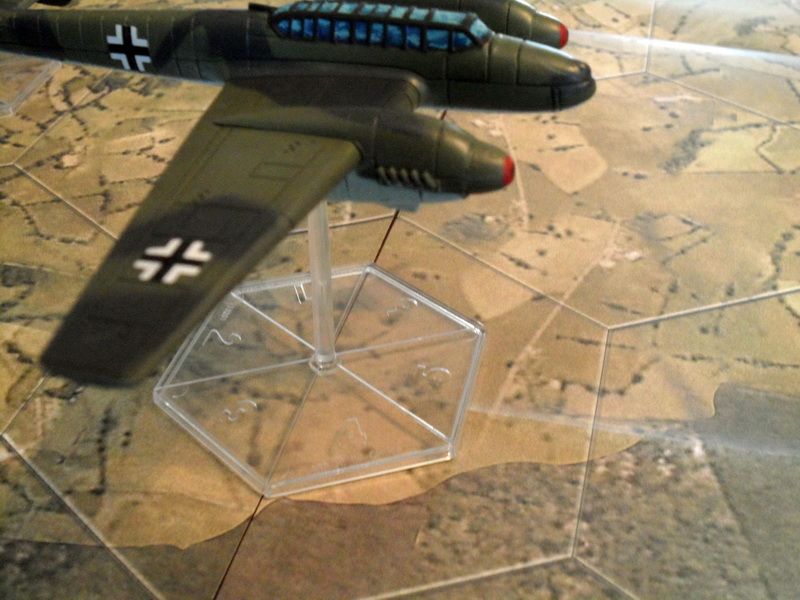 The two Hurricanes Mk1, the BF109e and the BF110c all share common attributes - only special rules are added as a unique feature.
The two Hurricanes Mk1, the BF109e and the BF110c all share common attributes - only special rules are added as a unique feature. The big circle with the numbers in it is the points value per airplane of the chosen type. The Kosciuszko squadron Hurricane comes at 31 points, while the regular Hurricane Mk1 comes at 27 points.
Both Hurricanes, which are of the same type, share the same Speed 2-3/4. This means that a player upon activating his airplane has to declare to his opponent whether he will move his airplane at normal speed which is 2-3 hexes, or fast speed which is 4 hexes. Planes must move their full speed.
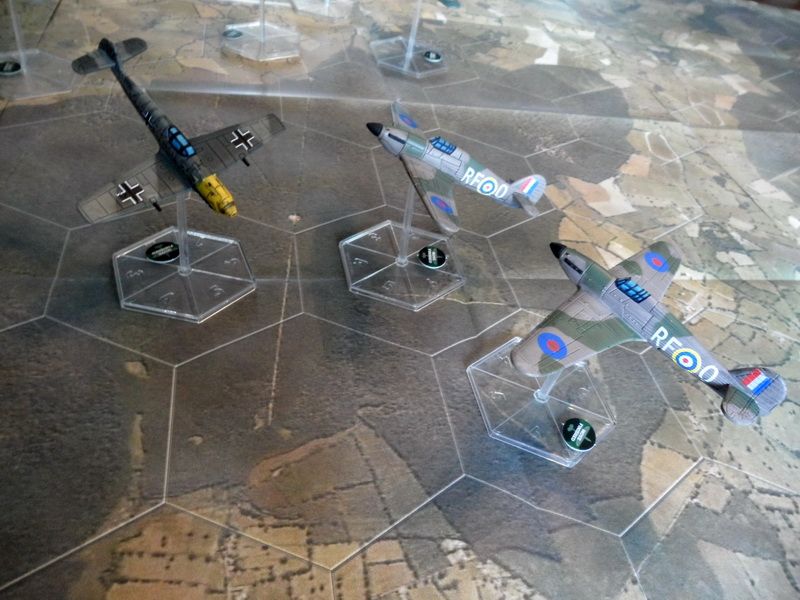 Then we have the Attack value, which for all fighters (except for the BF110c) is up to 3 hexes away from your front facing. At range 1 (when firing at an airplane in the adjacent hex) the MK1 Hurricane rolls six D6 dice. The amount of attack dice get lower the further away you are. When you roll to attack, all unmodified 6's always count as two hits, other than that the difficulty of hitting the opponent depends on a couple of factors which I will describe later.
Then we have the Attack value, which for all fighters (except for the BF110c) is up to 3 hexes away from your front facing. At range 1 (when firing at an airplane in the adjacent hex) the MK1 Hurricane rolls six D6 dice. The amount of attack dice get lower the further away you are. When you roll to attack, all unmodified 6's always count as two hits, other than that the difficulty of hitting the opponent depends on a couple of factors which I will describe later. Below this we have the Armor value, Vital value and Hit point value. Armor dictates how many hits an enemy needs to score towards your plane during his attack roll to inflict 1 damage point. The Vital value tells us how many hits, in a single roll, are required to instantly destroy your airplane. Hits tell us about the durability of our airplane. If the opponent, in a single roll, does score enough hits to equal your armor value you take a single damage point, if he wants to destroy you he must succeed in rolling equal to or higher than the Vital value. You can only either take 1 damage from a single attack or be instantly destroyed from a single attack in this game. A single fighter cannot score two damage points against a single enemy fighter.
Below this we have the Armor value, Vital value and Hit point value. Armor dictates how many hits an enemy needs to score towards your plane during his attack roll to inflict 1 damage point. The Vital value tells us how many hits, in a single roll, are required to instantly destroy your airplane. Hits tell us about the durability of our airplane. If the opponent, in a single roll, does score enough hits to equal your armor value you take a single damage point, if he wants to destroy you he must succeed in rolling equal to or higher than the Vital value. You can only either take 1 damage from a single attack or be instantly destroyed from a single attack in this game. A single fighter cannot score two damage points against a single enemy fighter.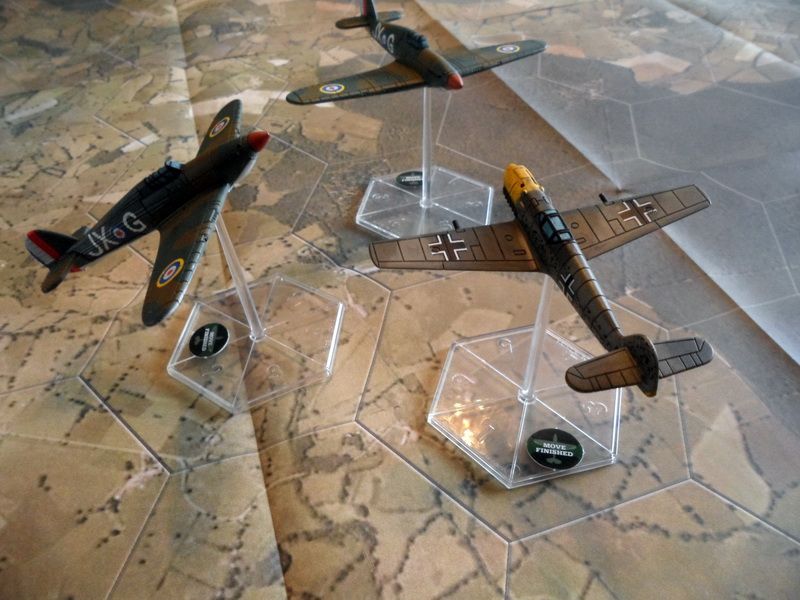 Then we have the maneuver attributes. The maneuvers (or "Difficult maneuvers" as they are called) in the game are classed and divided into turn, roll, dive and climb maneuvers. Much of the game is about outmaneuvering your opponent and finishing your move in the most favorable position, as such you will pretty much maneuver each turn and these values are very important. Each plane can normally perform 1 difficult maneuver per turn unless special rules state otherwise. To perform a maneuver the player rolls 2D6 and add the maneuver attribute bonus, for instance the Hurricane Mk1 gets +5 to all "Turn maneuvers". Maneuvers can be attempted at any point of your movement, however if your airplane goes at normal speed then you
Then we have the maneuver attributes. The maneuvers (or "Difficult maneuvers" as they are called) in the game are classed and divided into turn, roll, dive and climb maneuvers. Much of the game is about outmaneuvering your opponent and finishing your move in the most favorable position, as such you will pretty much maneuver each turn and these values are very important. Each plane can normally perform 1 difficult maneuver per turn unless special rules state otherwise. To perform a maneuver the player rolls 2D6 and add the maneuver attribute bonus, for instance the Hurricane Mk1 gets +5 to all "Turn maneuvers". Maneuvers can be attempted at any point of your movement, however if your airplane goes at normal speed then you 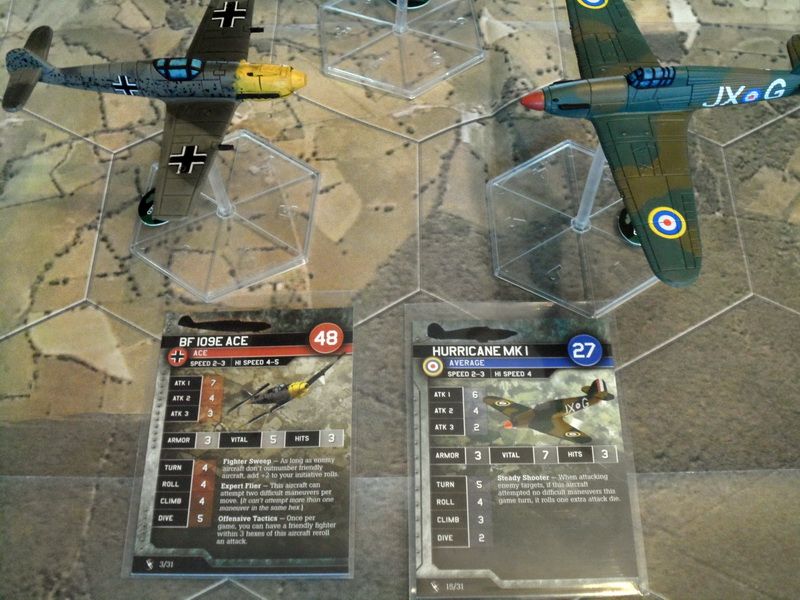 need to score a total of 10 on 2D6 + the maneuver bonus to succeed with your maneuver. If you use fast speed, you need to score 13 to succeed with the maneuver you want to perform.
need to score a total of 10 on 2D6 + the maneuver bonus to succeed with your maneuver. If you use fast speed, you need to score 13 to succeed with the maneuver you want to perform. 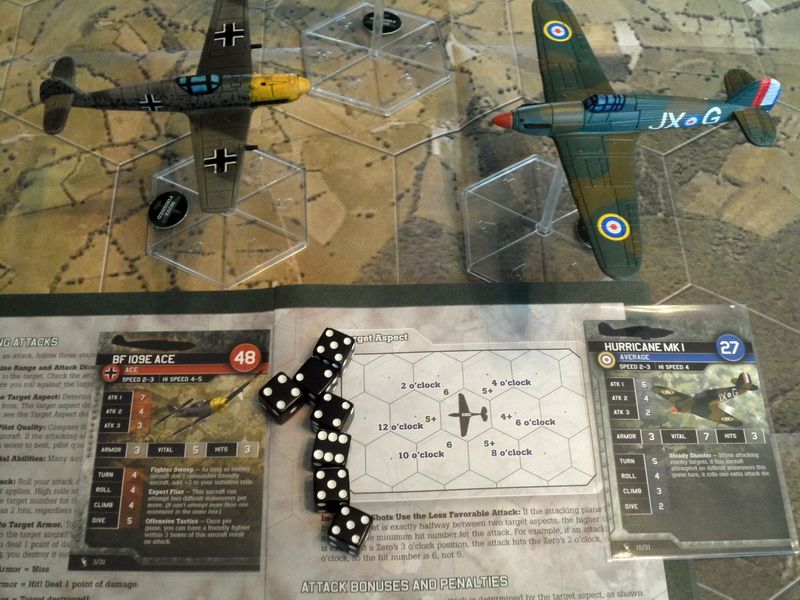 Finally you can finish your movement using a "status" - there are three options. If you want to attack someone at 1 altitude above you, then you need to tilt your plane upwards. If you want to attack someone 1 altitude level below you tilt the plane to nosedive. You can also tilt the plane sideways, to perform an "evade" and make it harder to hit. The drawback of using any such status is that you must move accordingly to your status next turn, this means that you must perform a climb/dive maneuver or begin your movement to the side towards which your airplane was evading. This will often use up your difficult maneuver for the following turn, and also make it a bit more predictable for the opponent as to where you are going.
Finally you can finish your movement using a "status" - there are three options. If you want to attack someone at 1 altitude above you, then you need to tilt your plane upwards. If you want to attack someone 1 altitude level below you tilt the plane to nosedive. You can also tilt the plane sideways, to perform an "evade" and make it harder to hit. The drawback of using any such status is that you must move accordingly to your status next turn, this means that you must perform a climb/dive maneuver or begin your movement to the side towards which your airplane was evading. This will often use up your difficult maneuver for the following turn, and also make it a bit more predictable for the opponent as to where you are going. So, the game is broken down into movement and shooting phase. The player who won initiative will move after the player who lost, but will also begin to fire second. Moving second is better as you get more chances of placing your airplane in better firing position. All planes finish their movement before the shooting phase begins.
So, the game is broken down into movement and shooting phase. The player who won initiative will move after the player who lost, but will also begin to fire second. Moving second is better as you get more chances of placing your airplane in better firing position. All planes finish their movement before the shooting phase begins. In order to shoot at your opponent there are several criteria that must be fulfilled. Your opponent bust be within 3 hexes of your front facing. The firing area is a circle of 7 hexes that has its center 2 hexes
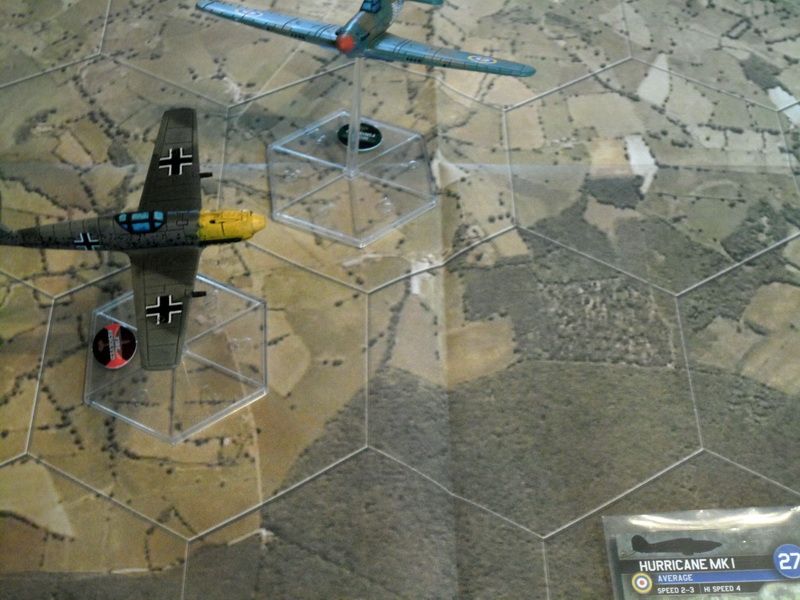 away from your front facing so it's a rather limited field of fire. Your opponent also needs to be at the same altitude as you if you want to fire at him - OR - you must have ended your movement with a Dive/Climb status which allows you to fire at someone that is 1 altitude level below or above yours.
away from your front facing so it's a rather limited field of fire. Your opponent also needs to be at the same altitude as you if you want to fire at him - OR - you must have ended your movement with a Dive/Climb status which allows you to fire at someone that is 1 altitude level below or above yours.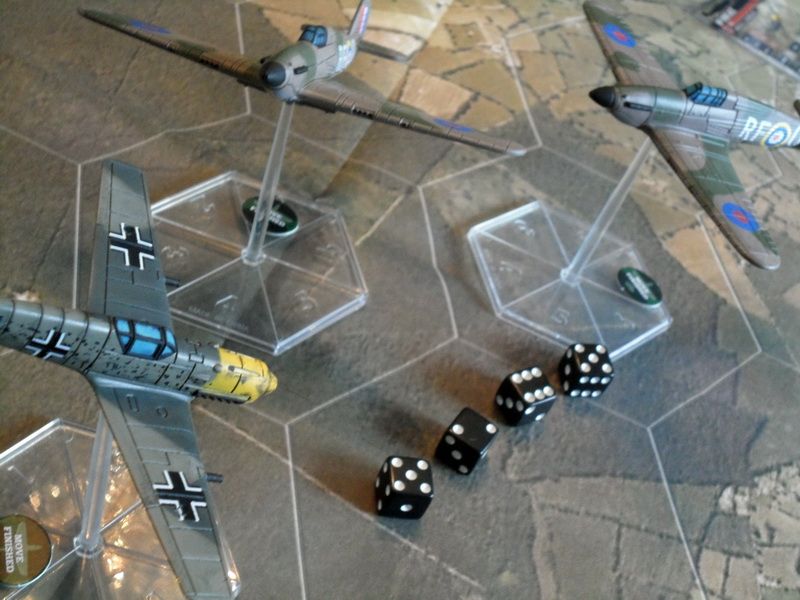 Next you check the firing angle, which is very important as it determines the D6 result needed to score a hit. Firing at someone from the 6 o'clock position allows you to hit on 4+, coming on from 10 o'clock on the other hand only allows you to hit on 6's. The to hit value can be modified in a couple of ways. Airplanes firing at someone below their altitude level gain +1 to hit on all their dice, planes piloted by pilots of a better rating than the target airplane also receive +1 to their hit roll. Evading airplanes inflict a -1 to hit penalty
Next you check the firing angle, which is very important as it determines the D6 result needed to score a hit. Firing at someone from the 6 o'clock position allows you to hit on 4+, coming on from 10 o'clock on the other hand only allows you to hit on 6's. The to hit value can be modified in a couple of ways. Airplanes firing at someone below their altitude level gain +1 to hit on all their dice, planes piloted by pilots of a better rating than the target airplane also receive +1 to their hit roll. Evading airplanes inflict a -1 to hit penalty  to all your attack dice.
to all your attack dice. Finally there is the status "Crippled airplane", this is an airplane that is down to its last hit point. These planes can only move at normal speed, perform difficult maneuvers at a -2 penalty, hit with -1 to all its hit dice and an enemy firing at a crippled aircraft gets +1 to his attack dice.
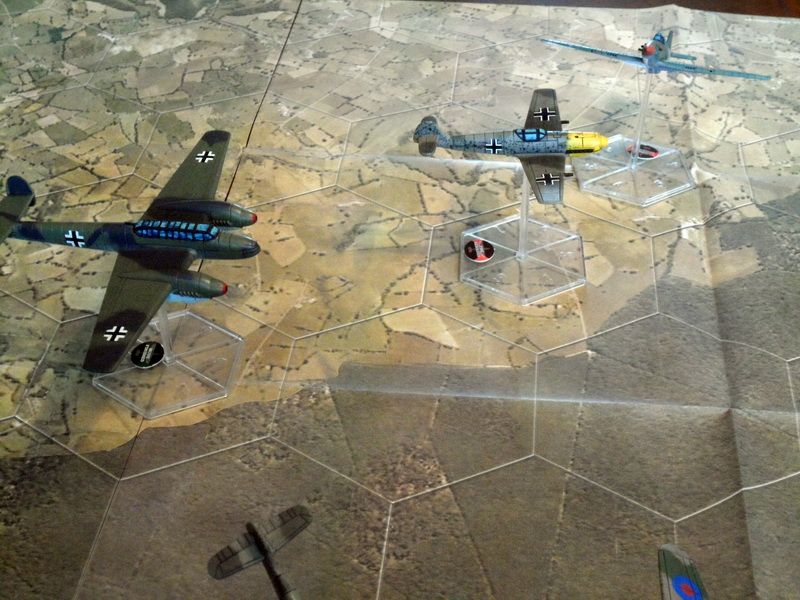 Shooting cannot normally be performed if two airplanes are in the same hex, and should two airplanes with the same altitude end up in the same hex they must roll a collision test which is 1D6 per plane. If both players roll 1 (or 1-2 for "Poor" rated pilots) they collide and are immediately destroyed.
Shooting cannot normally be performed if two airplanes are in the same hex, and should two airplanes with the same altitude end up in the same hex they must roll a collision test which is 1D6 per plane. If both players roll 1 (or 1-2 for "Poor" rated pilots) they collide and are immediately destroyed.There are a bunch of other special rules that cover night combat, moonlight, complete darkness, illumination, barrage balloons, clouds, flak fields and clouds. Clouds to me offer the most interesting aspect as it has a chart which players roll for at the start of the game - and this decides the clouds for the remainder of the game. This always
 mean that some altitudes are clear, some covered in light/heavy/solid clouds. This determines what planes can be attacked and the clouds are used to escape an enemy and preventing him from attacking you.
mean that some altitudes are clear, some covered in light/heavy/solid clouds. This determines what planes can be attacked and the clouds are used to escape an enemy and preventing him from attacking you.....
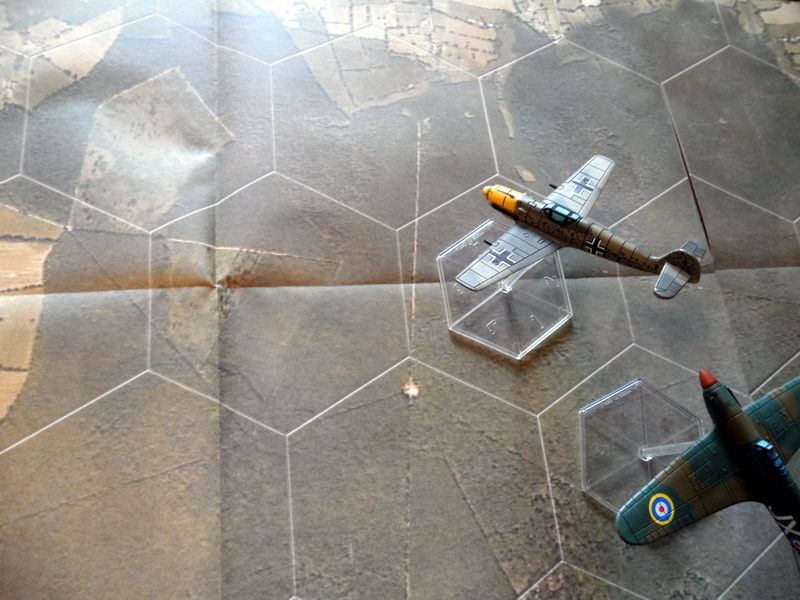 So what do I think about the game? Well it's fast paced as the limit of the game is 2-5 airplanes per side. Players should preferably build 100 point lists if possible so it is intended to be a small scale dog fighting game. It has enough depth and tactical options to make it interesting for gamers that want more than a beer & pretzels experience but it is simple enough to learn to retain that level of
So what do I think about the game? Well it's fast paced as the limit of the game is 2-5 airplanes per side. Players should preferably build 100 point lists if possible so it is intended to be a small scale dog fighting game. It has enough depth and tactical options to make it interesting for gamers that want more than a beer & pretzels experience but it is simple enough to learn to retain that level of  casual gameplay that doesn't require you to handle a ton of information or keep track of more than a handful of tokens and alternatives each turn.
casual gameplay that doesn't require you to handle a ton of information or keep track of more than a handful of tokens and alternatives each turn.The list building may be a bit restricted due to the fixed points on all airplane types and having the pilot rating/special rules fixed as well. On the other hand this allows you to quickly jump into a game and you will never have to worry about not knowing what options/upgrades are good/bad if you are unfamiliar with the game. This may also make it less prone to min/maxing lists.
The rulebook includes several scenarios, starting situations and options for scored skirmish games where you don't necessarily need to destroy your opponent in order to win. The many environmental special rules also add welcome depth which completely change the gameplay and add another layer to it.
 It should also lend itself to easy tweaks/house rules if you don't like the basic activation/turn order of things. For instance you could increase the role of the pilot rating by having rookies move before veteran pilots, and have veterans fire before rookies. But I recommend playing it with the standard rules a couple of times, you will notice that the +1 to hit towards lesser pilots is quite powerful on its own. Players could also agree to play with some kind of hidden speed/maneuver dials which are all planned out at the start of each turn but which are uncovered only as airplanes are activated one by one.
It should also lend itself to easy tweaks/house rules if you don't like the basic activation/turn order of things. For instance you could increase the role of the pilot rating by having rookies move before veteran pilots, and have veterans fire before rookies. But I recommend playing it with the standard rules a couple of times, you will notice that the +1 to hit towards lesser pilots is quite powerful on its own. Players could also agree to play with some kind of hidden speed/maneuver dials which are all planned out at the start of each turn but which are uncovered only as airplanes are activated one by one. I really like this game, it's not as crunchy and detailed as "Check Your Six" which I find to be a fantastic game, but for players who like a game that is easy to get into, quick to play and has microscopic amounts of book keeping this is something they should enjoy. It's hard to compare it to Star Wars X-wing rule wise as these two play very differently, but I do miss the hidden planning phase from X-wing. On the other hand, if I have 1 hour to play - I would prefer to set up a game of A&A: Angels 20 within two minutes and play that than spend 30 minutes at setting up and cleaning up a game of X-wing.
I really like this game, it's not as crunchy and detailed as "Check Your Six" which I find to be a fantastic game, but for players who like a game that is easy to get into, quick to play and has microscopic amounts of book keeping this is something they should enjoy. It's hard to compare it to Star Wars X-wing rule wise as these two play very differently, but I do miss the hidden planning phase from X-wing. On the other hand, if I have 1 hour to play - I would prefer to set up a game of A&A: Angels 20 within two minutes and play that than spend 30 minutes at setting up and cleaning up a game of X-wing.I can also see this lending itself easier and perhaps better to multiplayer participation games than X-wing.
Overall score 8/10

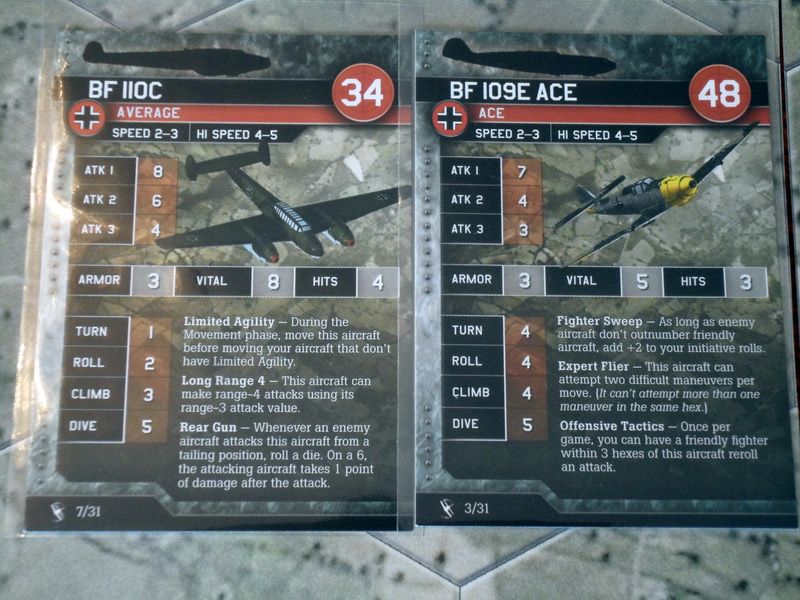
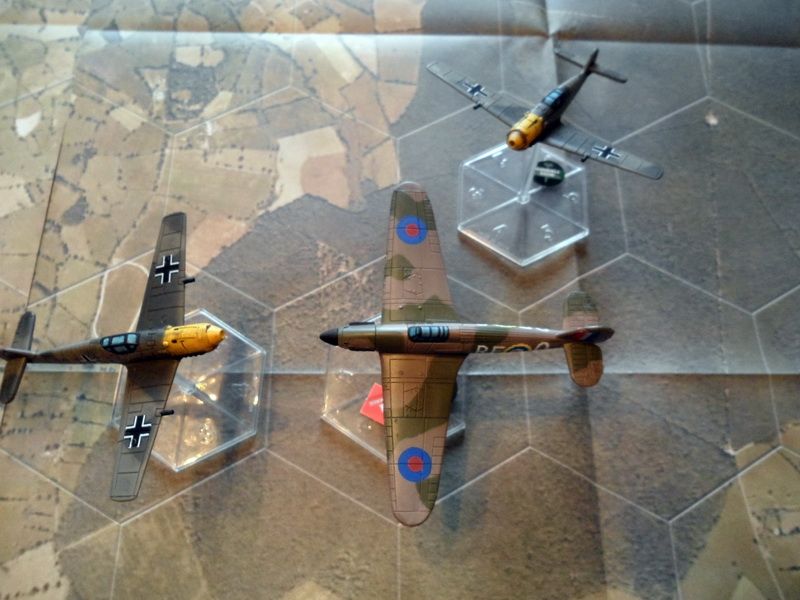
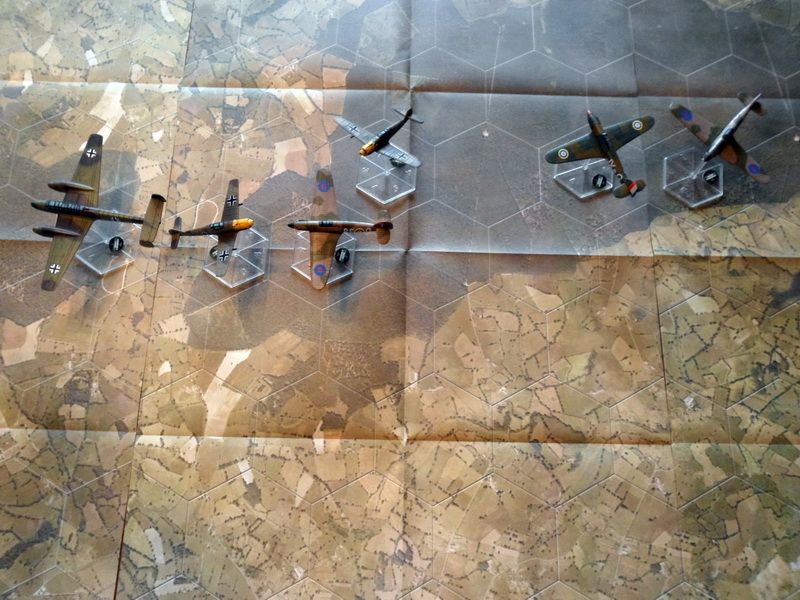
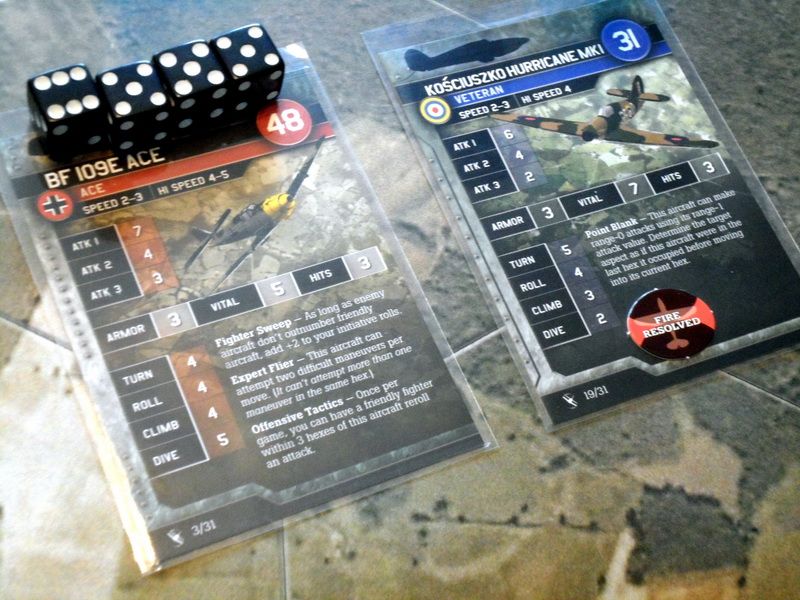

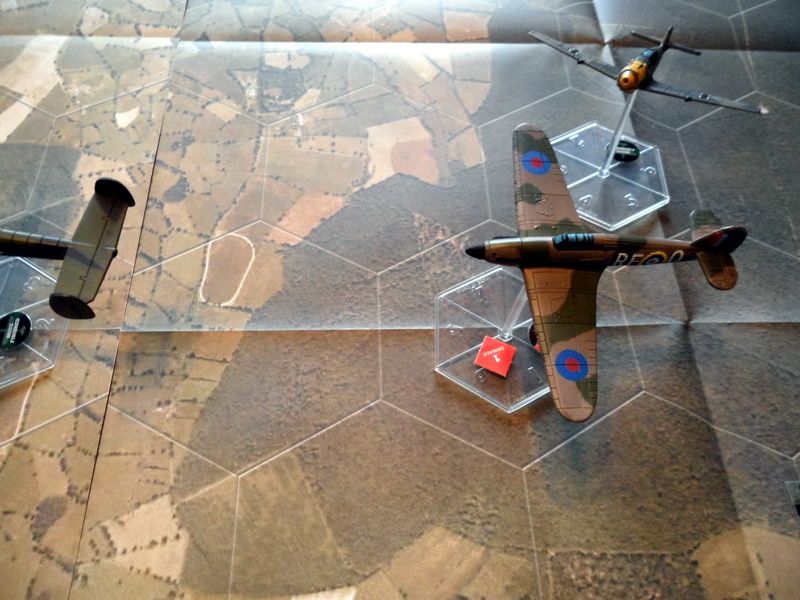
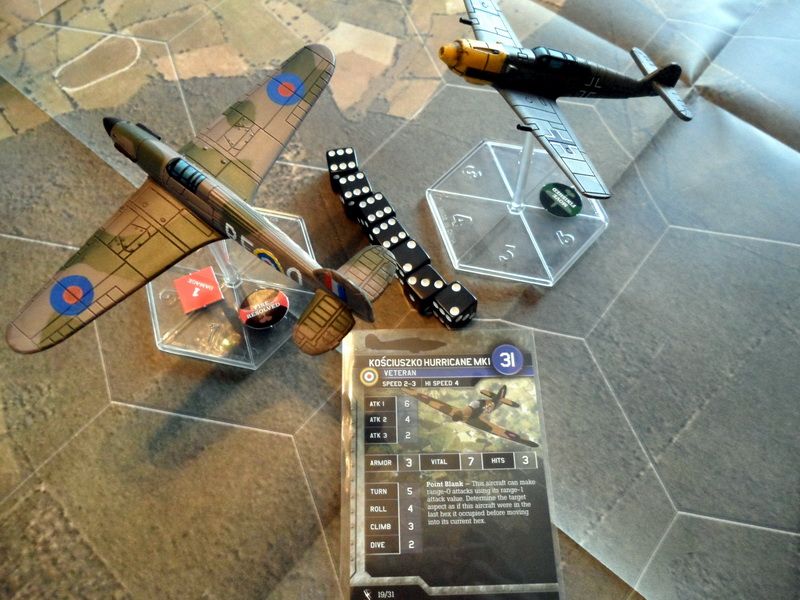

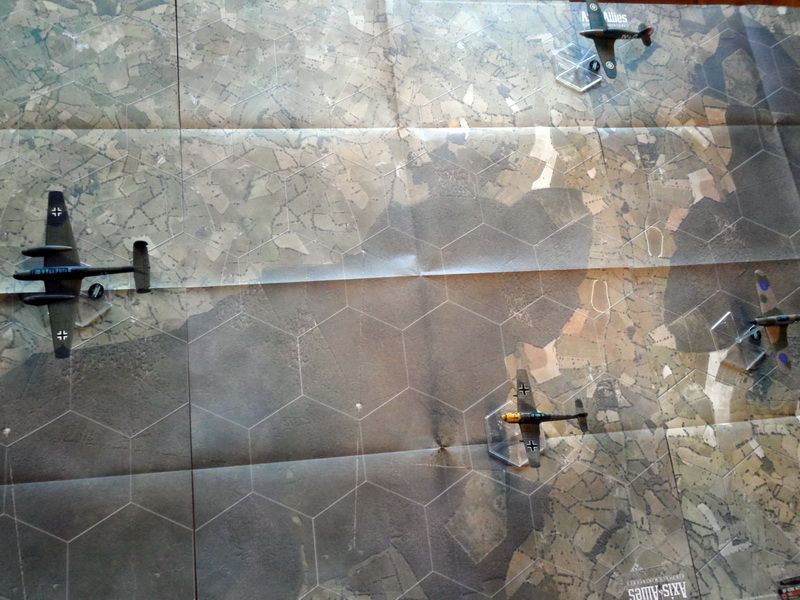
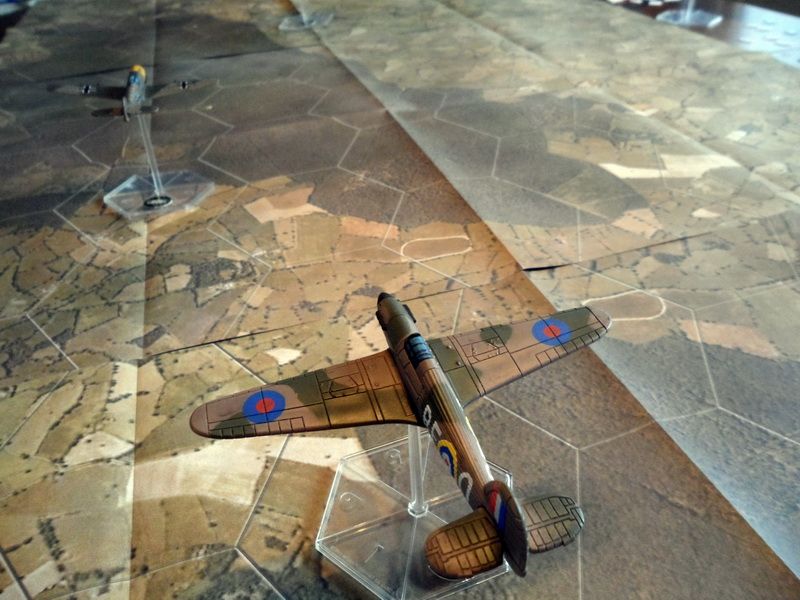
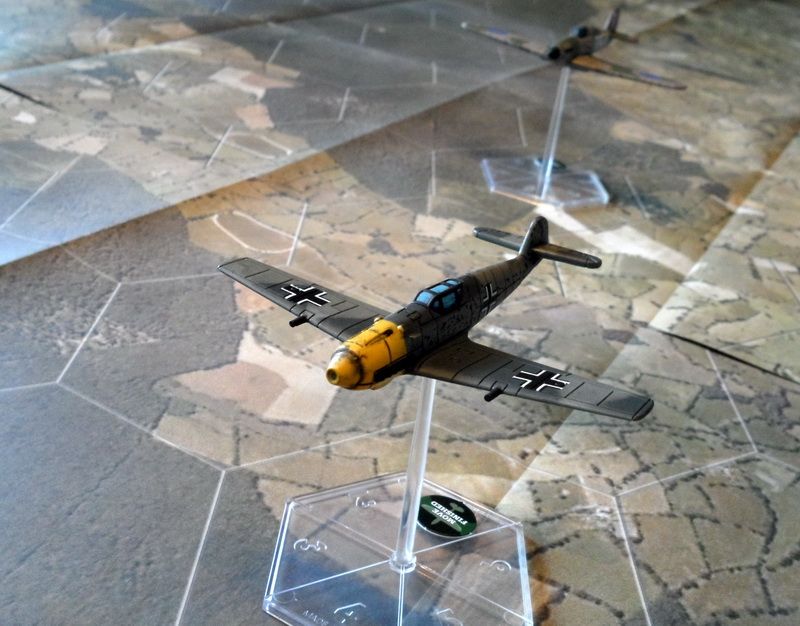
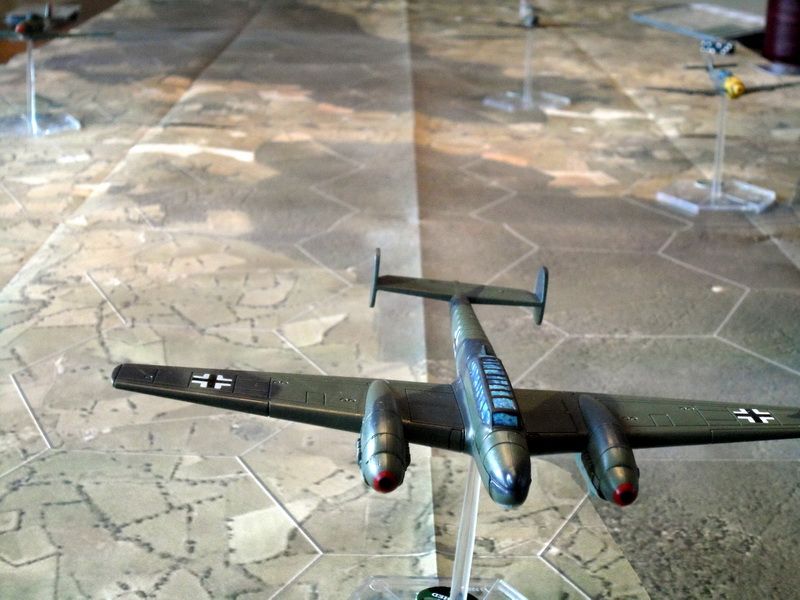
No comments:
Post a Comment